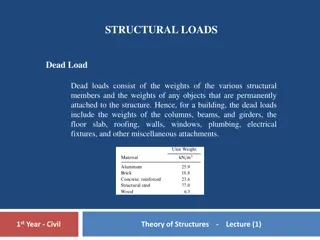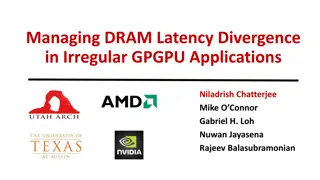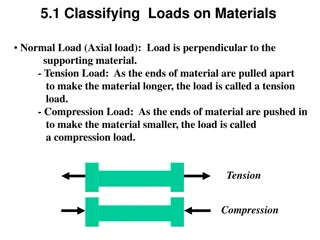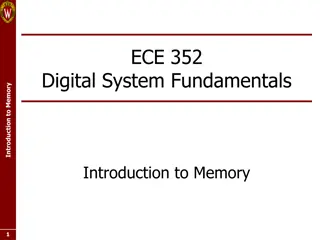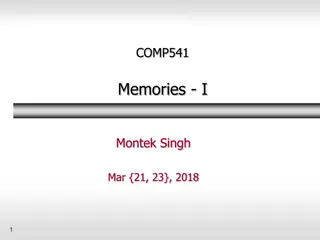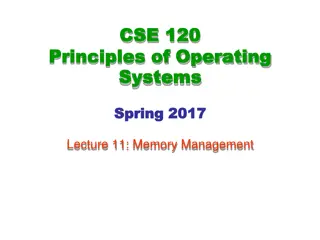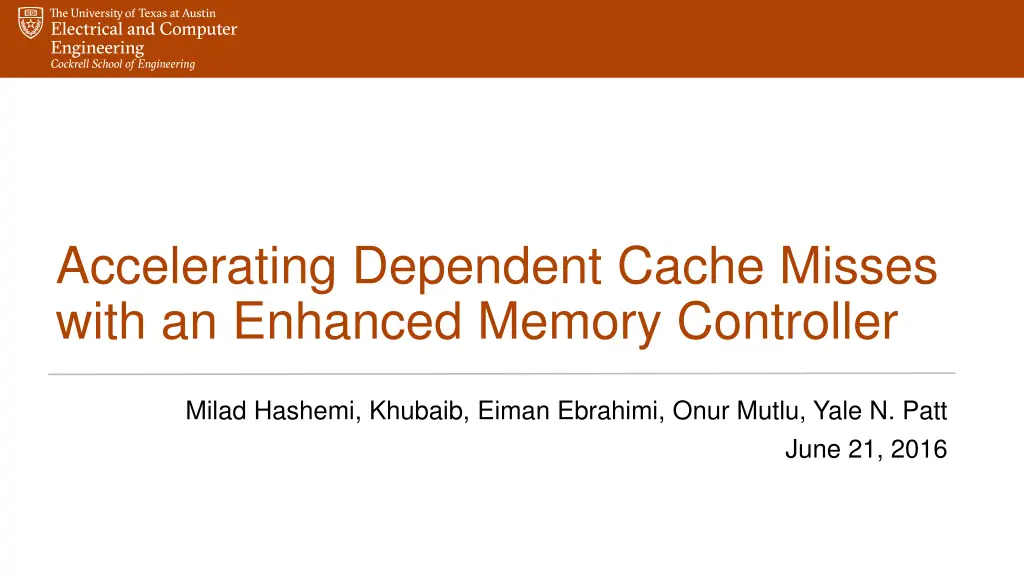
Enhancing Processor Performance Through Dependent Cache Misses Optimization
Explore how optimizing dependent cache misses with an enhanced memory controller can significantly improve processor performance. This study delves into the impact of effective memory latency on processor operations, presenting strategies to mitigate long-latency operations and enhance overall efficiency in pointer-dependent workloads.
Uploaded on | 0 Views
Download Presentation

Please find below an Image/Link to download the presentation.
The content on the website is provided AS IS for your information and personal use only. It may not be sold, licensed, or shared on other websites without obtaining consent from the author. If you encounter any issues during the download, it is possible that the publisher has removed the file from their server.
You are allowed to download the files provided on this website for personal or commercial use, subject to the condition that they are used lawfully. All files are the property of their respective owners.
The content on the website is provided AS IS for your information and personal use only. It may not be sold, licensed, or shared on other websites without obtaining consent from the author.
E N D
Presentation Transcript
Accelerating Dependent Cache Misses with an Enhanced Memory Controller Milad Hashemi, Khubaib, Eiman Ebrahimi, Onur Mutlu, Yale N. Patt June 21, 2016
Overview Dependent Cache Misses Enhanced Memory Controller Microarchitecture Dependence Chain Generation EMC Performance Evaluation and Analysis Conclusions
Effective Memory Access Latency The effective latency of accessing main memory is made up of two components: DRAM access latency On-chip latency
On-Chip Delay 100% 90% 80% Total Miss Cycles 70% 60% 50% 40% On-Chip Delay 30% 20% DRAM-Access 10% 0% 4xcalculix 4xpovray 4xastar 4xgamess 4xmilc 4xgcc 4xh264ref 4xbzip2 4xcactus 4xwrf 4xleslie 4xmcf 4xtonto 4xgromac 4xXalancbmk 4xzeusmp 4xomnetpp 4xsoplex 4xsphinx 4xbwaves 4xGemsFDTD 4xperlbench 4xlbm 4xlibquantum 4xnamd 4xhmmer 4xsjeng 4xgobmk 4xdealII
Dependent Cache Misses LD [P17] -> P10 MOV P10 -> P7 LD [P7] -> P13 ADD P3, P13 -> P20 LD [P20] -> P2 ADD P2, P3 -> P12
Dependent Cache Misses The impact of effective memory latency on processor performance is magnified when a cache miss has dependent memory operations that will also result in a cache miss Dependent cache misses form chains of long-latency operations that fill the reorder buffer and prevent the core from making forward progress Important in pointer-based workloads Dependent cache misses tend to have addresses that are difficult to predict with prefetching
Prefetching and Dependent Cache Misses 100% 90% All Dependent Cache Misses 80% 70% 60% GHB 50% Stream 40% Markov 30% 20% 10% 0% omnetpp milc soplex sphinx bwaves libquantum lbm mcf Mean
Dependence Chains LD [P17] -> P10 MOV P10 -> P7 LD [P7] -> P13 ADD P13, P3 -> P20 LD [P20] -> P2
Dependence Chain Length 12 from Source Miss to Dependent Miss Average Number of Operations 10 8 6 4 2 0 astar cactus leslie gamess milc mcf gromac zeusmp wrf omnetpp soplex bwaves povray gcc h264ref xalancbmk GemsFDTD perlbench tonto calculix hmmer sphinx libquantum lbm sjeng namd gobmk bzip2 dealII
Reducing Effective Memory Access Latency Transparently reduce memory access latency for these dependent cache misses Add compute capability to the memory controller Modify the core to automatically identify the operations that are in the dependence chain of a cache miss Migrate the dependence chain to the new enhanced memory controller (EMC) for execution when the source data arrives from main-memory Maintain traditional sequential execution model
Enhanced Memory Controller (EMC) Execution On Core On EMC Op 0: MEM_LD (0xc[R3] -> R1) Op 1: ADD (R2 + 1 -> R2) Op 2: MOV (R3 R5) Initiate EMC Execution Op 3: MEM_LD ([R1] -> R1) Op 4: SUB (R1 [R4] -> R1) Op 5: MEM_LD ([R1] -> R3) Registers to Core Op 6: MEM_ST (R1-> [R3])
EMC Microarchitecture No Front-End 16 Physical Registers NOT 256 No Register Renaming 2-Wide NOT 4-Wide No Floating Point or Vector Pipeline 4kB Streaming Data Cache
Dependence Chain Generation Cycle: 0 1 2 3 4 5 Live-In Vector: P3 6 LD [P17] -> P10 LD [P17] -> E0 MOV E0 -> E1 MOV P10 -> P7 Register Remapping Table: LD [P7] -> P13 LD [E1] -> E2 EMC Physical Register Core Physical Register P10 E0 ADD P3, P13 -> P20 ADD L0, E2 -> E3 P7 E1 LD [P20] -> P2 LD [E3] -> E4 P13 E2 P20 E3 P2 E4
Memory Operations Virtual Memory Support Virtual address translation occurs through a 32-entry TLB per core Execution at the EMC is cancelled at a page fault Loads first query the EMC data cache Misses query the LLC in parallel with the memory access A miss predictor [Qureshi and Loh: MICRO 2012] is maintained to reduce bandwidth cost Memory operations are retired in program order back at the core
System Configuration Quad-Core 4-wide Issue 256 Entry Reorder Buffer 92 Entry Reservation Station Caches 32 KB 8-Way Set Associative L1 I/D-Cache 1MB 8-Way Set Associative Shared Last Level Cache per Core Non-Uniform Memory Access Latency DDR3 System 128-Entry Memory Queue Batch Scheduling Prefetchers Stream, Markov, Global History Buffer Feedback Directed Prefetching: Dynamic Degree 1-32 EMC Compute 2-wide issue 2 issue contexts Each Context Contains: 16 entry uop buffer, 16 entry physical register file 4 kB Streaming Data Cache
Overhead: On-Chip Bandwidth H1-H10 observe a 33% average increase in data ring messages and a 7% increase in control ring messages Sending dependence chains and live-ins to the EMC Sending live-outs back to the core
Other Information in the Paper 8-core evaluation with multiple distributed memory controllers Analysis of how the EMC and prefetching interact EMC sensitivity to increasing memory bandwidth More details of EMC execution: memory and control operations 5% EMC Area Overhead
Conclusions Adding an enhanced, compute capable, memory controller to the system results in two benefits: EMC generates cache misses faster than the core by bypassing on-chip contention EMC increases the likelihood of a memory access hitting an open row buffer 15% average gain in weighted speedup and a 11% reduction in energy consumption over a quad-core baseline with no prefetching Memory requests issued from the EMC observe a 20% lower latency on average than requests that are issued from the core
Accelerating Dependent Cache Misses with an Enhanced Memory Controller Milad Hashemi, Khubaib, Eiman Ebrahimi, Onur Mutlu, Yale N. Patt June 21, 2016






